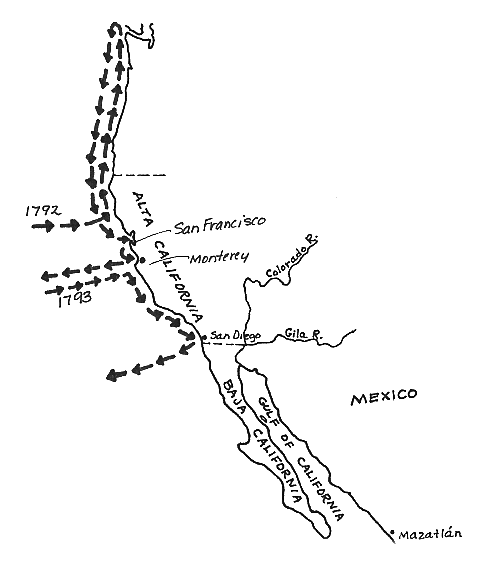| ||||
|
| ||||
|
GEORGE
VANCOUVER
 Lived:
1758-1798
Lived:
1758-1798
Explored California in: 1792-1794
Exploring for: England
Explored: by sea along the coast and inland on the San Francisco peninsula
EARLY HISTORY
George Vancouver was born in
Norfolk,
BACKGROUND
To make sure
VANCOUVER’S JOURNEY
Vancouver’s ship, the sloop-of-war
Discovery, left
Turning north, Vancouver surveyed the coast on his way to Nootka Sound. He explored Juan de Fuca Strait and determined that this waterway separated a large island (now Vancouver Island) from the mainland. On October 12, the Discovery headed south toward California, and arrived off the entrance to San Francisco Bay on November 14, 1792. The Discovery was the first non-Spanish ship to enter San Francisco Bay.
During the ten days they were anchored in San Francisco Bay, Vancouver and his men were well received by Hermenegildo Sal, commandante at the presidio (fort) there. He provided the visitors with a good supply of food for their ships. In turn, Vancouver presented Sal with some knives and table utensils, church ornaments, and barrels of wine and rum. Each group entertained the other with elaborate dinners.
Vancouver was surprised to see that the presidio was simply a few mud-brick buildings with only two old, broken cannon for defense. Using horses provided by Sal and escorted by Spanish soldiers, Vancouver visited the mission at San Francisco as well as Santa Clara Mission. This was further inland than any Europeans other than the Spanish had been in California.
Vancouver then sailed on to Monterey, where he was warmly welcomed by Lt. José Darío Argüello, in command at the Monterey presidio. Here Vancouver built an observatory on the shore so he could conduct scientific observations.
During the seven weeks the ships were anchored at Monterey, six men deserted. One was found, but on January 15, 1793, Vancouver sailed for winter quarters in Hawaii, leaving five deserters behind.
Vancouver’s second visit to Monterey was in the fall of 1793. He stayed only a few days, for the new acting governor in Monterey, José de Arrillaga, made it clear that the English were not welcome. Arrillaga did not want outsiders to see how poorly defended the Spanish settlements were.
This time Vancouver sailed south, stopping briefly in Santa Barbara. He passed Pueblo de Los Angeles, and reached San Diego on November 27. The commandante at the San Diego Presidio knew he was not to allow Vancouver to stay, but he tried to be welcoming anyway.
In his journal, Vancouver left the first detailed description of San Diego after its Spanish settlement, from a visitor’s viewpoint. He praised the missions for their kindness to him, and left them an unusual gift. It was a barrelled organ for use at Mission San Carlos Borromeo. This organ later found its way to Mission San Juan Bautista.
Vancouver returned to California
for a third time in November 1794. Diego de Borica had just been appointed
governor. Now the visitors were again welcomed. Several of the men who had
deserted in 1793 were returned to their duty. Vancouver stayed until early
December, when he left California and headed back to
WHAT HE ACCOMPLISHED
A Voyage of Discovery to the
Pacific Ocean and Round the World was published in 1798 in London. In
this complete report, Vancouver told of the rich land with good harbors. He
also told how little the Spanish had developed the land, and how poorly it
was defended. His descriptions brought more interest in California, and led
to the challenge of
LATER YEARS
Back in